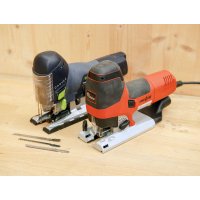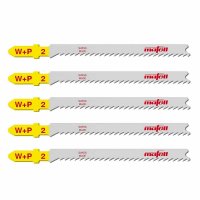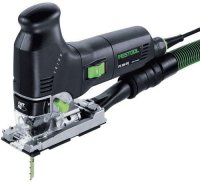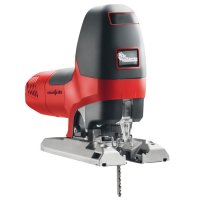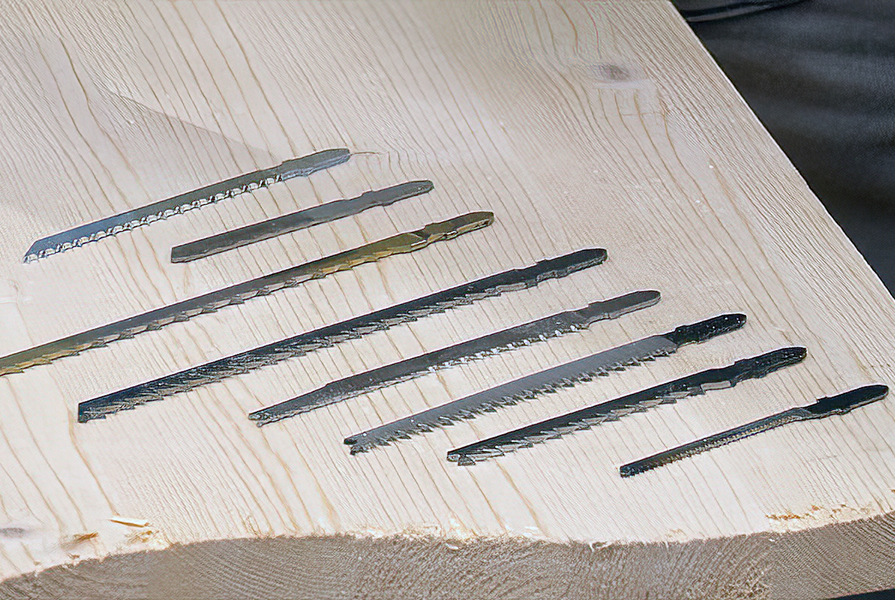
The best cutting results with the pendulum jigsaw are guaranteed by matching your saw blade to the material. But how do you find the best jigsaw blade for your projects? We give tips on how to choose a jigsaw blade that suits the worked material.
Material and tooth shapes with jigsaw blades
The task of a saw blade is to separate material. For the saw blade to cope well with this task, it must be harder than the material to be cut. The four main blade materials for jigsaw blades are:
- HCS / carbon steel: ideal for sawing soft wood, softer plastics or fibreboard made of wood
- HSS / fully hardened high-speed steel: for sawing harder materials such as metal, aluminium and non-ferrous metal
- BIM / Bi-Metal (a combination of HCS and HSS): ideal for sawing hardwood, hard plastics and metals
- HM / tungsten carbide for professional cutting of fibre reinforced plastic, cement fibre boards and plasterboard
Compared to portable circular saws, there is a much larger range of different saw blades for pendulum jigsaws. Almost every manufacturer offers its own brand of saw blades and names them individually. This can be very confusing. Basically, you can classify jigsaw blades according to their tooth shape and tooth spacing. The closer the tooth pitch, the smaller and finer the saw blade and the more teeth there are. In the opposite case, there are fewer, larger teeth.
Jigsaw blades for wood
Saw blades for woodworking are available in standard lengths of 75, 105 and 145 mm. They also allow for sawing of very thick materials. You should, however, scale down your expectations regarding the cutting being perpendicular to the workpiece surface when sawing very thick workpieces, as the longer saw blade will most likely bend. Jigsaw blades for wood are selected primarily according to the planned cutting direction: Rip cuts, crosscuts or curved cuts.

Rip cuts in solid wood: Cuts along the grain produce long-fibred chips, which in turn require larger spacing between the saw teeth.
Rule of thumb: The thicker the material, the fewer teeth per millimetre the saw blade should have.
The larger distance creates a larger cutting area, thus improving chip removal. This increases the cutting speed and reduces the force required to feed the machines. Disadvantage: the quality of the cut edges can be worse.
Our recommendations for straight rip cuts:
MAFELL W2 and Festool S 75/4/5 for fast cuts
MAFELL W3 and Festool S 105/4/5 for greater material thicknesses
Crosscuts in solid wood,as well as cuts in wood composite boards: For clean smooth cutting edges, the tooth shape and the number of teeth are decisive. To achieve the smoothest possible cutting surfaces and tear-free cutting edges, we recommend very high-quality saw blades with ground and set teeth. There are saw blades with teeth of different lengths and tooth lengths that shorten towards the head. Like the Japanese Ryoba hand saw, the finer teeth that emerge first in the sawing motion produce a better cutting edge.
Our recommendations for clean crosscuts:
MAFELL W+P2 and Festool S 75/2,8/5 Wood Straight Cut
Curved cuts: Saw blades for tight curves are significantly narrower than those for straight cuts. The narrower the saw blade, the easier it is to bend. That is why blades for cutting curves are usually somewhat shorter. They are therefore more suitable for thin materials.
Our recommendations for curved cuts:
MAFELL W4 and Festool S 75/4 K/5 Wood Curves
Saw blades for metal
These saw blades differ considerably from those for woodworking. They have very short teeth. A kind of set can therefore only be achieved by the saw blade body having a wave shape, as it is also used in coping saws for metal. When cutting metals, set the speed of your jigsaw to medium and switch off the orbital (pendulum) action.

Our recommendations for metal:
MAFELL Stichsägeblatt M2 and Festool HS 105/1 BI/5 Metal
Jigsaw blades for plastics
These jigsaw blades usually have a neutral tooth position and relatively short, even teeth. The pendulum action must be switched off when machining plastics. The motor speed is set to about half maximum so that little frictional heat is generated and melting of the plastic is avoided.

Our recommendations for plastics:
MAFELL W+P2 for soft plastics and acrylic
Festool HS 75/3 BI/5 Plastics Solid Material for solid plastic parts
MAFELL E+F2 for GRP
Saw blades for laminate and resin-bonded particleboards
To work on these very hard materials, you need tungsten carbide saw blades that have a significantly longer service life than standard blades. They are usually also suitable for cement fibreboards, plaster fibreboards and Formica boards. When cutting one of these materials, set the speed to medium and switch off the orbital (pendulum) action.

Our recommendations for laminate:
MAFELL Jigsaw blade L2 and Festool S 75/2,5/5 Wood Fine Cut

